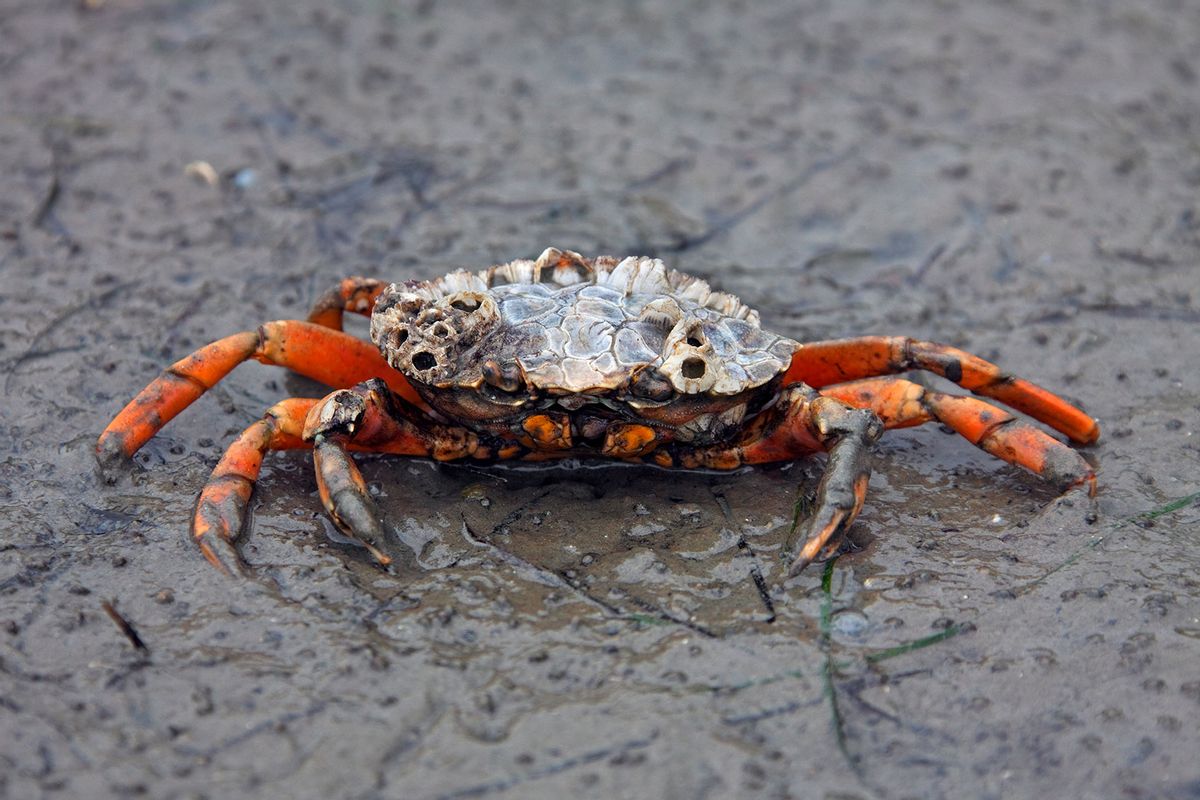On restaurant menus across New England, green crabs are showing up in everything from bouillabaisse and bisques to croquettes and crudo. The umami-packed crabs are harvested locally — often a big selling point for diners. What patrons may not realize, however, is that by indulging in green crab for dinner, they're also working to combat the growth of an invasive species.
European green crabs have been found in the Atlantic from New Brunswick to South Carolina, as well as in Puget Sound and along the West Coast. They are not native to these waters, where they easily outcompete native fish and shellfish for food and habitat. With few natural predators, invasive green crab populations have dug in, overtaking the eelgrass beds that native birds and fish depend upon to survive. They are also voracious eaters of clams, mussels and scallops, making them a huge threat to the billion-dollar shellfish industries on both coasts.
While green crabs have been here for a while — it's believed they were first introduced to North America in the 1800s after catching a ride on merchant ships from Europe — the climate change-induced trend of warming waters and milder winters has led their populations to explode in recent years.
In an effort to reduce their numbers, a network of biologists, fishers, chefs and other food business owners are taking a page out of an old book: If you can't beat 'em, eat 'em.
Introducing Invasivorism
While the campaign to consume more invasive green crab has ramped up over the last few years, the act of catching, hunting or foraging invasive species for the purpose of eating them is nothing new. The concept even has its own term — invasivorism — which was first coined by Joe Roman, a conservation biologist and researcher at the University of Vermont, in the early 2000s.
During part of his PhD research in organismic and evolutionary biology, Roman chose to study the genetics of the European green crab to try to better understand how the species got to North America — and how its population expanded so rapidly. He collected crabs from Provincetown, Massachusetts, all the way up to Nova Scotia, where he met a fisherman collecting periwinkles, an invasive sea snail native to Europe, to sell to restaurant markets in Boston and New York.
TERMS TO KNOW
Invasivorism: The act of catching, hunting or foraging invasive species for the purpose of eating them.
"I had been working on trying to reduce the impacts of our appetites," says Roman. "Think about the loss of Atlantic cod or bison, both of which almost disappeared as a result of human hunting. It occurred to me that maybe we could put our destructive streaks to good use for change, and actually encourage people to harvest these invasives."
Combating invasive species by turning them into marketable foods was an attractive idea. Invasives can negatively impact both the health of ecosystems and the economies that rely on those environments. They pose a significant threat to agricultural production, causing crop loss and food insecurity. According to a 2021 study, invasive plants and animals cost the economies of the United States, Canada, Mexico and the Caribbean at least $1.26 trillion between 1960 and 2017. Those costs have climbed in recent decades, growing from $2 billion per year in the 1960s to over $26 billion per year in the 2010s. The U.S. has experienced the greatest economic impact in the region. There are an estimated 6,500 invasive species — both plant and animal — now established in the country.
Roman's invasivorism idea took a while to catch on, but eventually it started gaining traction — thanks, in part, to the locavore movement that started to emerge around 2005. Several years later, in 2011, Roman founded Eat the Invaders, an educational website that details how to use invasive species in cooking. Since then, we've seen chefs and adventurous home cooks experiment with lionfish, purple sea urchins, bullfrogs and wild pigs.
"I'm not about punishing invasives. They didn't do anything wrong. Humans made the mistake of bringing them here," says Roman. "The goal, of course, is to restore the ecological health and biodiversity of these areas where invasive species are found, and not in any way to make these species a villain. Treat them with the respect that they deserve but also acknowledge that there's true ecological harm in having them outside of their native area, and some sort of mitigation is going to be necessary."
There are several approaches that can be taken to reduce invasive species populations once they become established. Eating them, as opposed to culling them, is one of the least wasteful ways to do so — and especially with marine invasives, it can also help a local ecosystem by easing demand for other species that are overfished. "Whether it's for food, for jewelry or other things, there are lots of creative ways to use invasive species," Roman says.
Does Eating Invasives Make a Difference?
This year, California experienced one of its wettest winters in decades. The precipitation has been good for replenishing once-depleted reservoirs plagued by years of drought. It has also led to a destructive superbloom of black mustard, a fast-growing invasive plant that chokes out native vegetation relied on by native pollinators and, in turn, the birds that eat them.
Unsurprisingly, the superbloom wild mustard has attracted foragers and chefs eager to showcase its peppery flowers and leaves in dishes. Jutta Burger, science program director for the California Invasive Plant Council, understands the appeal. "It is based out of an interest — and very valid interest — in wanting to forage from the land, and see whether we can make lemonade out of lemons and do something that benefits both humans and benefits the environment," she says.
Yet Burger is highly skeptical of eating as an effective control method. "That really is a positive message for consumers and for business folks and chefs and such, in a time when we do get a lot of messaging that there are a lot of changes in our environment that we can do nothing about. So I think people are wanting to hear messages like that," she says. "But the trouble is: Is it a correct message?"
In many ways, invasive plants are even harder to eradicate than invasive animals. "One of the reasons that it's not likely to be effective as a control method is because the goals of harvesting for foods are very different from treating or removing plants from an area," Burger explains. "When you do the latter, you have to remove everything, the crappy plants with mold on it, as well as the one in the perfect stage for harvest. If you're going out to make a fine, gourmet meal, you're going to look for the best parts of that plant. You're going to be selective in what you collect, and that selectivity itself makes the harvesting ineffective for controlling a plant."
Experts agree: Eating invasive species isn't going to solve the issue. For starters, only a fraction of those species are safe for humans to eat. It's also unrealistic to expect consumers to eat every single last green crab, lionfish or periwinkle. But finding another purpose for invasives is better than just leaving them to wreak havoc.
"No matter how hard we try, we will never be able to eat our way into eliminating green crabs," says Mary Parks, founder and director of GreenCrab.org, a nonprofit founded in 2020 to build culinary markets for European green crabs while spreading awareness of their impact. "We will never be able to harvest them to the point where they are no longer a threat in any capacity. They are simply too aggressive of an invasive. They [re]produce too fast. But we can potentially mitigate their impact by harvesting them."
Even Roman knows invasivorism is only one of many tools when it comes to restoring ecosystems affected by invasives. But he points to the recent efforts to reduce populations of invasive lionfish in the Atlantic Ocean, Gulf of Mexico and Caribbean Sea as an example of how it can still have an impact.
Starting in 2015, the Florida Fish and Wildlife Conservation Commission has organized an annual Lionfish Challenge, which awards prizes to whoever harvests the greatest number of lionfish during a four-month season. Since the challenge's inception eight years ago, it's been touted as one of the most successful "eat invasive" campaigns, with more than 165,000 lionfish harvested. The flaky white fish has made its way onto menus in places like Florida, Georgia, South Carolina and Puerto Rico, where it has been turned into tacos, fritters and more.
Invasivorism is never going to be enough to eradicate the problem entirely. But in recent years, biologists fighting invasives have begun embracing a new strategy known as functional eradication. Instead of eliminating invasive species altogether, this approach focuses on managing them — in part, by eating them — and suppressing populations to a low enough level where their harm is limited. "We're not going to eat every last lionfish. There's just no way," explains Roman. "But we could have pressure on lionfish in certain areas where it can make an ecological difference."
The Chef Connection
When it comes to invasivorism, one of the biggest challenges in convincing consumers is the lack of familiarity. Many in the U.S. are familiar with blue crabs and Alaskan king crabs, both of which can be picked for their sweet meat. European green crabs, however, are small and not especially meaty, meaning people might not know what to do with them. Instead of trying to pick a steamed or boiled green crab, they're better eaten in soft-shell form or used to make flavorful stocks, sauces and butters.
"In the U.S., we're not super used to cooking with and eating smaller crab species," says Parks. "But this isn't the case in a lot of other parts of the world, including Venice and Vietnam. So it's really useful, in talking about green crabs, to look at other applications."
An important part of GreenCrab.org's strategy has been enlisting chefs and restaurateurs in their efforts to get consumers interested in eating the invasive. "Once you have gotten them into the hands of enough restaurants, other people get excited about them," Parks notes. "It's really chefs who are going to be the tastemakers."
Still, we don't want the demand for these invasive species to grow too big. "We're not trying to make this sustainable," says Roman, speaking on the popularity and longevity of "eat invasive" campaigns. "Extinction, in this case, is a happy ending."
In Illinois, the state government has worked with chefs to rebrand the invasive Asian carp as "copi" (short for "copious"), the goal being to bring a new appeal to the once-unpopular fish. Getting more copi on local menus is one way officials plan to curb the growth of the invasive fish in the state's rivers, as well as the Great Lakes. But the positive impact may extend beyond the environment. "This is something we can benefit from in our low income communities where there's food deserts," says Kevin Irons, assistant chief of fisheries at the Illinois Department of Natural Resources. "We can get copi from our Illinois River and to Chicago much more affordably then we can fly in some frozen fish . . . from the Philippines," for example.
"It's not the silver bullet. This won't take care of all of our problems, but we believe it can change the dynamic and provide some room for our native fish," says Irons. "We're trying to use all the tools in a toolbox, and this is one of the big hammers."


Shares